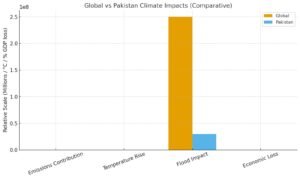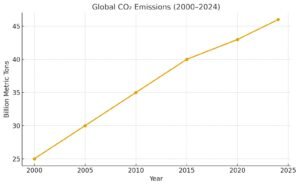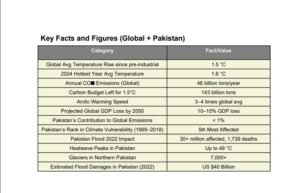Global Warming: The Situation is Worse Than Generally Believed
Introduction
The climate crisis has moved beyond the realm of forecasts—it is a lived reality shaping the 21st century. From catastrophic floods in Pakistan to record-breaking heatwaves in Europe and Asia, global warming is advancing more rapidly than once feared. What was earlier considered a distant challenge is now a pressing emergency, demanding not only scientific acknowledgement but also immediate political and social action.
1. Global Overview: Why Warming is Accelerating
Scientists agree that the Earth has already warmed by more than 1.5°C compared to pre-industrial levels. This figure is not just symbolic—it marks a threshold after which extreme weather patterns multiply.
-
Polar amplification: The Arctic and Antarctic are warming several times faster than the global average, accelerating ice melt and sea level rise.
-
Carbon budget depletion: At current emission levels, humanity has less than a decade before permanently overshooting the 1.5°C target.
-
Feedback loops: Forest loss, methane release from thawing permafrost, and ocean acidification are reducing Earth’s natural capacity to absorb greenhouse gases.
-
Heat extremes: Heatwaves that once occurred once in 50 years are now happening once a decade, affecting agriculture, water supplies, and human health.
The planet is not simply getting warmer—it is entering a cycle of self-reinforcing damage that is difficult to reverse.
2. The Human and Economic Costs
Global warming is no longer just an environmental issue; it is an economic and humanitarian crisis.
-
Economic damages: Global GDP could shrink by up to 10–15% by mid-century due to extreme weather, declining crop yields, and infrastructure destruction.
-
Food insecurity: Rising temperatures reduce staple crop productivity (wheat, maize, rice). By 2050, hundreds of millions could face hunger.
-
Water scarcity: Glacial melt and shifting rainfall patterns are placing immense stress on freshwater systems.
-
Health impacts: Heat stress, spread of vector-borne diseases, and respiratory illnesses from wildfires are on the rise.
-
Mass migration: Climate-induced displacement is growing. By 2050, tens of millions of people may become climate refugees, intensifying global instability.
3. Pakistan: A Ground Zero for Climate Change
Although Pakistan contributes less than 1% of global greenhouse gas emissions, it is among the top five most vulnerable nations. Its geography, dependence on agriculture, and fragile economy amplify the risks.
-
Floods 2022: Over 30 million people were affected, thousands killed, and damages estimated at $40 billion. Such floods are no longer “once in a century” events—they may repeat every decade.
-
Heatwaves: Cities like Jacobabad and Nawabshah are frequently hitting nearly 50°C, making them among the hottest places on Earth. Such temperatures are edging close to levels where the human body cannot survive outdoors for long.
-
Glacial melt: With more than 7,000 glaciers, Pakistan’s north is highly prone to glacial lake outburst floods (GLOFs). These sudden floods threaten communities and vital infrastructure.
-
Agriculture stress: Shifts in monsoon patterns and heat stress are undermining wheat, cotton, and rice—the backbone of Pakistan’s economy.
-
Urban vulnerability: Karachi, Lahore, and other major cities face compounded risks of flooding, heat islands, and air pollution.
For Pakistan, climate change is not a debate—it is a lived disaster shaping livelihoods, development, and even national security.
4. Global Injustice and Climate Politics
The crisis also raises questions of justice and equity:
-
Unequal responsibility: Developed countries are responsible for more than two-thirds of historic emissions, yet developing nations like Pakistan bear the brunt of consequences.
-
Loss and damage financing: There is growing global debate over whether wealthy nations should compensate vulnerable countries for irreversible losses.
-
Geopolitical tensions: Climate change intensifies competition for water, food, and land, which may fuel conflicts. South Asia’s strained water relations are an example.
-
Policy inertia: Despite agreements like the Paris Accord, global commitments remain inadequate. Current pledges still place the world on track for 2.5–3°C warming—a catastrophic scenario.
5. Why the Situation is Worse Than Generally Believed
The severity of global warming is underestimated because:
-
Scientific conservatism: Climate scientists often understate projections to avoid alarmism. Reality is outpacing their warnings.
-
Invisible damages: Many impacts—such as soil degradation, biodiversity collapse, or slow-burning drought—are less dramatic but equally destructive.
-
Short-term politics: Governments prioritize immediate growth over long-term survival.
-
Underreported adaptation failures: Even where countries have adaptation policies, implementation lags far behind the urgency of the crisis.
6. The Way Forward
-
Drastic emission cuts: Renewable energy, carbon pricing, and efficiency measures must accelerate at an unprecedented pace.
-
Resilient infrastructure: Cities, dams, and transport systems need redesigning to withstand floods, heat, and storms.
-
Water governance: Countries like Pakistan must reform irrigation, conserve groundwater, and manage rivers with climate sensitivity.
-
Regional cooperation: South Asia must address shared vulnerabilities rather than fuel tensions—especially on water resources.
-
Climate justice: Wealthy nations must deliver on financing promises, while vulnerable countries must enhance transparency and governance in utilizing aid.
7. Important CSS-Relevant Questions
-
Critically analyze why climate change is advancing faster than previous projections.
-
Pakistan contributes little to global emissions but ranks among the most vulnerable countries. Discuss.
-
Evaluate the economic, social, and security impacts of climate change on Pakistan.
-
How can Pakistan strike a balance between development needs and climate adaptation?
-
Discuss the concept of climate justice and its relevance for developing countries.
-
Examine the role of international agreements in mitigating climate change. Are they sufficient? Why or why not?
-
Suggest a comprehensive roadmap for Pakistan to mitigate and adapt to the climate crisis.
Conclusion
Global warming is not a slow-burn crisis anymore; it is unfolding in real time with devastating consequences. The situation is indeed worse than generally believed because the pace of change is faster, the damages are deeper, and the political responses remain inadequate. For Pakistan, climate change is both a development challenge and a survival threat. For the world, it is the defining test of human responsibility in the 21st century.




